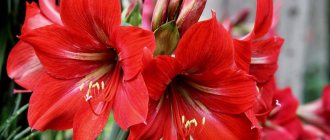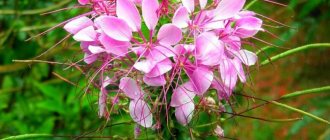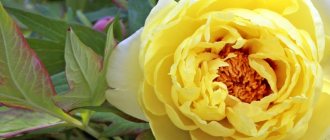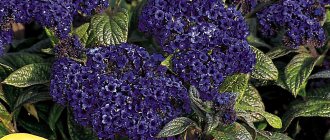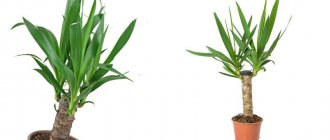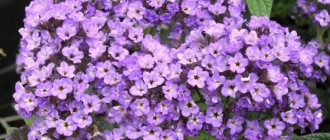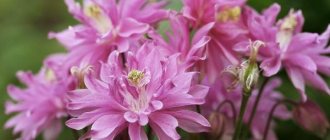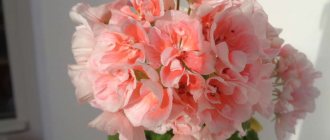Heliotrope flower: description of popular plant species and options for use in garden design
Semi-shrubs and herbaceous perennial plants do not require special care. The decorative crop has obovate, alternately arranged foliage of dark green color. Leaves with pubescence, wavy or wrinkled type, are located on fairly short petioles.
The flowers are small, fragrant, purple or dark blue in color, collected in dense corymbose inflorescences. In indoor floriculture, heliotropes can grow for several years, but in garden culture they are grown as a flowering, highly decorative annual. After flowering, fruits full of seeds are formed. Hybrid heliotrope is especially popular.
G. thyroid or thyroid
The tallest decorative species. The height of an adult plant reaches 120 cm. The above-ground part is represented by well-shaped stems and long, lanceolate, boat-shaped leaves. The outer part of the leaf blade has a slightly darker color. The flowering is beautiful and long-lasting, with blue or blue flowers collected in inflorescences up to 8-10 cm long. The culture is widely used as a background for creating multi-tiered flower beds, and is also suitable for group and single plantings.
G. peruvian
Peruvian or Tree-like is one of the most common species in culture , and is a spreading bush with a height of the above-ground part of up to 40-60 cm. Fragrant and beautiful flowers of dark purple or rich bright blue color are collected in relatively large inflorescences that bloom before frost. The most popular hybrid forms include the “Marin” series. It is often used in group flower arrangements and single plantings when decorating the landscape of a personal garden.
G. Kurasavsky
The species is a spreading, rather tall shrub. The diameter of the above-ground part is often 110-120 cm, with an average height of no more than 60-100 cm. The flowers are pale bluish-white, collected in inflorescences with a strong and long peduncle. The plant combines well with conifers and decorative deciduous perennials.
G. stem-encompassing
The shortest species, not particularly popular among amateur gardeners. The ornamental plant is distinguished by long lanceolate leaves with characteristic wavy edges and attractive purple flowers. In landscaping it is used as a carpet plant and planted to decorate borders and flower beds. Serves as an excellent complement to salvia, tuberous begonia and garden petunia.
G. European
The perennial species “European” is characterized by a bush-like form with a height of the above-ground part of up to 35-40 cm. The foliage is greenish-yellow in color. The flowers are distinguished by original curls and a white corolla. They are located in the axils of the upper leaves. During the active flowering phase, the entire plant is covered with lush and dense inflorescences.
Features of the variety and description
Heliotrope Marin is a tree-like shrub, the height of which often reaches half a meter. The leaves are arranged alternately on short cuttings, which is why the crop has a rather lush shape. Small flowers of rich blue-violet color are collected in inflorescences in the form of corymbs. The plant is also characterized by the presence of fruits, which consist of four parts - nuts. These parts can contain up to one and a half thousand seeds, the total weight of which is only 1 gram.
The first flowering of indoor crops can occur in the same year as sowing. The buds begin to set in early June and open after about a week. With proper care, the flowering period lasts until the cold weather. Perhaps it is precisely because of this that the perennial heliotrope Marin is so loved by gardeners. However, without proper care, the plant may die, so let's look at the basic rules for growing it.
The best plant varieties
Despite the very large number of natural species, varieties belonging to the Peruvian or tree species (H. peruvianum, arborescens) have become widespread in culture. Such varieties are characterized by relative unpretentiousness, very abundant and fragrant flowering.
In flower beds, the crop can be very successfully combined with coreopsis and different types of begonias, rudbeckias, as well as mixtures of coleus. Among other things, a very effective flower combination can be obtained by planting different varieties of heliotrope in combination with petunia or cineraria.
Combination with other plants
Heliotropes are a wonderful crop that goes well with many plants. For example, begonias, coreopsis, rudbeckias, coleus and many other flowers can be planted nearby. Very effective compositions are obtained by planting heliotropes with cineraria and petunias. There are a lot of possible combinations.
The culture is very successfully used in landscape design. Its long and bright flowering allowed it to take pride of place among the plants used to decorate personal plots. Heliotropes are used to decorate beautiful flower beds and form flower borders. The flowers look especially impressive against the backdrop of a bright green lawn. Plants for home growing in pots are no less interesting. They are used to decorate balconies and terraces. In this case, they are given the shape of a small tree on a trunk.
How to sow heliotrope seeds (video)
Heliotrope “Sea Breeze”
The “Sea Breeze” variety is a compact ornamental plant with a height of the above-ground part of up to 40-45 cm, with bright fragrant inflorescences. The flowers are small in size, dark blue or dark purple in color, collected in corymbose inflorescences. Flowering is abundant and long lasting. The foliage is dark green with a purple tint. The leaves have a very characteristic obovate shape for the species.
Heliotrope "Dwarf Marine"
“Sea Dwarf” variety It is characterized by the formation of attractive and very fragrant inflorescences consisting of bright blue flowers.
"Odysseus"
The variety "Odyssey" is a perennial plant grown as an annual. The variety is represented by a densely branching herbaceous bush with an above-ground part up to 25-30 cm high. Flowering is very abundant and long-lasting. The bush produces small and extremely fragrant flowers, collected in characteristic corymbose inflorescences. The highly decorative crop is used for landscaping balconies and loggias, is used in potted plants and in the design of carpet flower beds in personal plots.
"Princess Marina"
The variety “Princess Marina” is a compact and relatively low plant, distinguished by flowers with an intense violet-blue color. The inflorescences are quite lush and highly decorative, characterized by a weak and unobtrusive aroma.
"White Lady"
The varietal feature of the heliotrope “White Lady” is a compact and low-growing, abundantly flowering crop. It is distinguished by buds of a pleasant soft pink color. At the stage of full dissolution, the flowers acquire a snow-white color.
"Regal Dwarf"
Compact bush-like form, characterized by the formation of large and very fragrant flowers. Its short stature and decorative appeal have proven this variety excellent in indoor floriculture and in the design of garden flower beds.
Growing heliotrope from seeds
As a rule, approximately three to four months pass from germination to the phase of active mass flowering , so sowing work is recommended to be carried out from the last ten days of February to mid-March. It is best to prepare a nutrient mixture for growing based on non-acidic peat and medium-grained sand in a ratio of 4:1. You can also use regular store-bought flower soil.
Planting containers with drainage holes must be filled with moist, disinfected soil mixture. Sowing is done superficially or with a slight sprinkling of a nutrient mixture, which will prevent the risk of drying out. Crops must be covered with plastic film and installed in a room with a temperature regime of 18-20°C. After the mass emergence of seedlings, flower seedlings need to be provided with a sufficient amount of light and air temperature within 20-22°C. Diving into separate seedling pots is done after three or four leaves appear.
Planting technology
Before transplanting seedlings to a permanent place, it is necessary to provide the plants with hardening measures. Planting flower seedlings in open ground flower beds is carried out after the threat of damage to the ornamental crop by late return frosts has passed.
In the first weeks after planting, it is advisable to provide protection to young and immature plants using a frame-film cover. The planting scheme may vary depending on the species and varietal characteristics . Before planting, it is necessary to add high-quality humus to the planting hole, after which the root system of the plant is carefully placed and buried in soil. After compacting the soil, it is very important to water sufficiently abundantly with settled water.
Features of culture
Young Marin heliotropes resemble herbaceous plants. But over time, the shoots become woody. With the help of pinching or proper pruning, they can be turned into bushes or trees. An unusual plant came to Russia at the end of the eighteenth century and very quickly gained popularity among the population, thanks to its unique smell and bright color.
Currently it is grown on balconies, in rooms, on terraces. And in open ground, borders are formed from it.
Heliotrope: home care
When growing indoors, it is very important to follow a few simple recommendations:
- the crop needs to be provided with sufficient lighting while protecting the above-ground part from direct sunlight. It is considered optimal to place it on windowsills facing east and west;
- sufficient thermophilicity presupposes compliance with the temperature regime. In spring and summer, the temperature when visiting should be approximately 20-24°C. With the onset of autumn and winter, the temperature regime is no more than 16-18°C;
- Air humidity indicators require special attention. It is necessary to use regular spraying of the above-ground part with warm and settled water;
- With the beginning of active growing season and before flowering, the ornamental crop needs abundant and regular moistening of the earthen clod. Do not overdry or over-moisten the nutrient substrate in a flower pot. Water for irrigation must be soft and at room temperature;
- fertilizing is carried out from March until the end of the period of mass flowering. Complex mineral fertilizers are applied twice a month.
Indoor heliotrope needs to be replanted every year, around mid-March. The decorative perennial needs to be removed from the flower container, the damaged roots should be cut off and planted in a new flower pot that has a larger volume. A drainage layer must be poured onto the bottom of the planting container. After replanting, the above-ground part must be pinched.
A nutritious soil substrate based on four parts of turf substrate, a couple of parts of deciduous soil, a couple of parts of non-acidic peat and one part of coarse sand with the addition of a small amount of crushed charcoal and granular complex fertilizer is optimally suited for cultivation. Before replanting, the nutrient mixture must be disinfected in the oven.
Reproduction
Heliotrope can be propagated both by seeds and by cuttings. Material for seedlings can be obtained independently or purchased in specialized stores. If you decide to use the latter option, you should choose only trusted manufacturers. The flower is quite capricious. In Russia, seeds practically do not ripen, and cuttings may die due to non-compliance with storage temperature conditions.
Sowing of seeds is carried out from February to March. The optimal soil composition is peat and sand mixed in equal proportions. Before sowing, the soil is compacted evenly, and then the seeds are placed on the surface. They must be sprinkled with earth on top, but not more than 1-2 mm.
For seeds to germinate, it is necessary to maintain a constant temperature of about 20 degrees.
Important! For landing, choose a place protected from strong winds.
For better germination, you need to cover the pot with glass or film, then place it in a well-heated place with a source of indirect sunlight. Sprouts appear after 10-20 days. When they reach a height of about 7-10 cm, they need to be picked and planted. If you plan to plant heliotrope in open ground, it is better to use decomposable pots. This will make further care easier.
For planting by cuttings, young shoots of the main bush are used. The optimal time for cuttings is from January to February. Planting is done in containers with soil, which are then covered with cups to create a greenhouse effect. In addition, after disembarkation, it is necessary to create a special light regime, namely to simulate a 10-hour daylight hours.
The care and planting in open ground of the “Marin” variety is slightly different. This heliotrope belongs to the tree type, therefore it can reach a height of more than a meter.
Important! Despite the fact that this variety is, in fact, a tree, planting it in open ground will not allow it to grow more than half a meter in height. In addition, the root system is close to the surface, therefore, it will most likely die when cold weather sets in.
For cuttings, the plant is dug up, moved into a pot according to size, and then brought into a warm room for the winter. In mid-February, the main bush is divided into cuttings. Each of them must contain at least 4 internodes. Most of the foliage along with the inflorescences is cut off. Before planting on the site, it is necessary to place the cuttings in liquid for root formation.
The composition of the soil for planting is a mixture of sand and peat (1:2 ratio). A layer of sand about a centimeter thick is poured on top. The plant takes about a month to take root. During this period it is especially vulnerable. It must be covered with film, watered and ventilated regularly.
After the start of the thaw (April-May), the sprouts are periodically taken outside for hardening.
You can grow heliotrope seedlings for open ground from seeds
Please note that the flower must be planted in the soil only when the plant forms at least three nodes with leaves
For planting in the ground, a bed of the following composition is prepared: peat, turf, sand (ratio 4:2:1). It is recommended to put a little humus at the bottom of the hole. Before the flowering period, it is necessary to protect the plant from direct sunlight, otherwise there is a risk of foliage burns.
Features of outdoor care
To grow a profusely flowering and highly decorative plant, it is recommended to allocate areas well lit by the sun or with slight shading. The soil of the flower garden must be prepared in advance. The main feature of standard care for heliotrope of any type and variety is timely and moderate irrigation measures. To moisten the soil, it is advisable to use rainwater heated in the sun.
Immediately after irrigation activities, it is advisable to loosen the soil around ornamental plants a little. Such an event can be combined with the removal of weeds. Mulching the soil in flower beds gives very good results. For this purpose, you can use almost any organic matter, including sawdust and leaves and compost. To get the most abundant and long-lasting flowering, it is recommended to periodically pinch the stems.
Caring for a flowering plant
On your site, heliotrope will bloom from June until frost.
- Watering. Look by the age of the flowers. Yesterday's seedlings need to be watered frequently in order for them to take root (especially if the weather is very dry). Water an adult plant, even a flowering one, only if all the soil on top of the flowerbed has dried out.
- Feeding. For heliotrope, you can buy a complete (complex) mineral fertilizer for flowering crops. From the moment of transplanting into the ground until the peak of flowering (when all the clusters bloom), apply a fertilizing solution twice a month. In autumn, the plant no longer needs to be fed.
- Pest control. Heliotrope is to the taste of spider mites, whiteflies and aphids. Some people do not fight these insects at all, allowing a total infestation in the area, from which other flowers also suffer. I don’t save money and a day or two to buy insecticide. Pests should be eradicated in time, because they harm the beauty of heliotrope. You will not be able to inhale poison in the open air. But in order to get the greatest benefit from the treatment (spraying), keep an eye on the weather forecast - immediately after treatment, rain should not wash away the chemicals from the flowerbed.
- Treatment of diseases. If heliotrope grows in a lowland, in a place where groundwater is high, it rains for a long time or you constantly “play” with watering, the bushes may develop rust or gray rot. In the case of a low-lying area, it is difficult to do anything, except maybe next time build a high flower bed, the basis of which should be more drainage (broken brick, slate shards, and so on). In other cases, treating the flower bed with a fungicide will help.
In open ground in winter frost the flower will die. But if you plant the best bushes in a pot and move it to your apartment, it will remain growing here until spring (although it will require constant additional lighting).
A girl who has had it blooming in her garden for many years will tell you more about growing heliotrope:
Heliotrope: pinching (video)
The plant can be damaged by whiteflies, aphids or dangerous spider mites, to destroy which the aerial parts should be treated with a special modern preparation, Actellik. As a result of excessive irrigation measures and excessive accumulation of moisture in the soil near the root system, gray mold damage to ornamental crops can occur. At the first signs of fungal infection, fungicide treatment is performed.
All types of heliotropes are very impressive and are highly decorative. It is possible to get a new bush of this perennial crop yourself not only by sowing seed material, but also by cuttings. However, it must be remembered that only a limited number of varieties and hybrid forms are suitable for cultivation at home and in garden floriculture.
Pests and diseases
For Marin heliotrope, the danger is represented by the whitefly, which has an external resemblance to a moth or small butterfly. Plants affected by whitefly become covered with cloudy yellowish spots, and the leaf blades curl and stop developing. For prevention, the room in which the flowers are located is regularly ventilated. In case of infection, use a soap solution or insecticide (Marin heliotrope is treated 2 times at intervals of a week).
Proven folk remedies for whiteflies - infusion of garlic or yarrow
Getting rid of spider mites on Marin heliotrope is much more difficult, since the pest is very small in size. The most suitable time to combat spider mites is autumn, when they acquire a noticeable orange color. Signs of crop infection are multi-colored spots (from yellow and red to silver).
Important! Spider mites cannot tolerate high humidity, so you can get rid of the parasite with abundant watering.
It is worth pruning leaves with traces of damage, which will stop the further spread of the mite.
Gray rot on leaves can occur due to regular waterlogging or lack of sunlight. Droopy leaves indicate insufficient moisture. If the tips of the leaves curl, the air is too dry. Light or yellowed leaves indicate insufficient light levels or excessively high temperatures.
